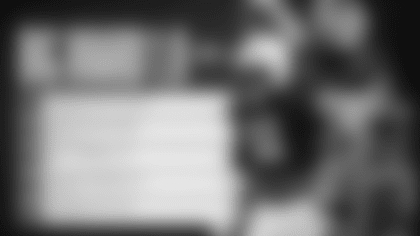The Patriots inability to roster an elite offensive playmaker is the most frustrating part about being a Pats fan over the last half-decade.
New England's well began running dry when Tom Brady exited stage right for Tampa Bay, with lacking skill talent partially contributing to Brady's departure. Then, it continued into the Mac Jones era.
The Patriots drafted a distributor from the pocket in Jones, who was surrounded by multiple first-round picks on his championship team at Alabama. Yet, it was not a priority nor were they successful in the investments they did make to build a winning offense around Jones. As a result, Jones was in over his head, and he flamed out after three seasons.
With a fresh start at quarterback on the horizon, it's inexcusable for the Patriots to continue striking out at the wide receiver position. It needs to be a priority that de facto general manager Eliot Wolf addresses with premium assets. Frankly, it's been an organizational failure that the Patriots haven't been able to upgrade their receiver talent, especially given how much talent enters the league every year through the draft.
As hard as it has been to stomach other offenses having multiple Pro Bowl receivers while the Patriots don't have any, there's potentially a light at the end of the tunnel in the 2024 NFL Draft. By my count, the 2024 class has 20 wide receivers with top-100 projections, making this, by far, the best receiver group we've studied since beginning to rank prospects in 2019.
With the hay in the barn as the pre-draft process comes to a close, here are my final wide receiver tiers for the 2024 NFL Draft:
Note: I base pro comparisons on playing style. When you watch this guy play, who does he remind you of and why? Don't look at them as setting expectations for career accolades. For example, when I compare Rome Odunze to DeAndre Hopkins, I'm not saying that ten years from now Odunze will be a five-time Pro Bowler with seven 1,000-yard seasons. There's no way to predict that. Again, it's comparing skill sets—also, shoutout to Hayden Winks for compiling Draft Twitter's best player comps.
Tier One - Instant Star/Offensive Centerpiece
1. Marvin Harrison Jr., Ohio State
Pro Comparison - Davante Adams, Position: X receiver
The only challenge to Harrison's pro projection is finding a weakness in his game. The 6-foot-3, 209-pound receiver checks nearly every box for a prolific wide receiver at the next level. He can beat you on the vertical route tree with straight-line speed, ball-tracking ability, contested catch skills, and body control to adjust to off-target throws. Then, he can reduce inside to the slot where he'll win at the top of the route with sudden route breaks and an advanced understanding of how to attack DBs. Harrison is excellent off the line of scrimmage; he torched single and double coverage as the receiver who drew the most attention in college football last season, and he averaged 3.4 yards per route run despite shaky quarterback play in 2023.
The only area where Harrison didn't receive an "A+" grade was in producing yards after the catch, where he only forced five missed tackles last season as a ball carrier. Overall, Harrison is the most complete wide receiver prospect since Julio Jones and A.J. Green (2011) at age 21. MHJ should step in as an instant WR1 with star potential to headline an NFL offense.
2. Malik Nabers, LSU
Pro Comparison - Odell Beckham Jr., Position: Z receiver
Although we don't subscribe to having Nabers over Harrison Jr., the logic behind it is fair. Nabers is a three-level burner who can just as easily take a three-yard slant 80 yards to the house as he can run by the entire defense for an 80-yard touchdown. Nabers has exceptional build-up speed and start-stop ability to elude defenders while creating vertical and horizontal separation. He also has a standout trait of tracking the ball over the shoulder and accelerating to chase down the deep ball. As a 20-year-old on draft night, Nabers led the entire class in yards per route run (3.6) with inside-outside versatility (54-46 split) and the ability to win at all three levels.
Nabers's game-breaking play speed will make him a Tuesday player, where opposing defenses must account for his ability to score from anywhere on the field. That could lead to brackets/doubles, tilting coverage/safety help his way, or forcing your top cover corners to travel into the slot. Thus, creating opportunities for others as well as himself, which is very intriguing for teams looking to find players who alter defensive game plans.
3. Rome Odunze, Washington
Pro Comparison - DeAndre Hopkins, Position: X receiver
Harrison Jr.'s and Nabers's big-play ability gives them a slight edge as prospects, but it wouldn't be surprising if Odunze ends up being the most productive pro. The Washington product is a classic outside/X receiver with the size (6-3, 212) and vertical speed (4.45s) that are ideal for a player who lined up on the outside on 82% of his snaps in 2023. He's highly efficient off the line of scrimmage and does a great job of tempoing his routes to set up corners for sudden bursts that create separation. However, his best trait is his 75% contested catch success rate, where his ability to play through contact and body control to adjust to throws outside his frame is eerily reminiscent of D-Hop. Odunze doesn't have the breakaway speed that Harrison Jr. or Nabers possess. But he's a nuanced receiver with elite hands that gobble up everything within his catch radius. He'll be a quarterback's best friend.
Tier Two - Impact Rookie/WR1 (1B) Potential
The tier two receivers could still be WR1s for many offenses or be an excellent Robin to Batman: DeVonta Smith-A.J. Brown, Tee Higgins-Ja'Marr Chase, Jaylen Waddle-Tyreek Hill.
4. Brian Thomas Jr., LSU
Pro Comparison - slim DK Metcalf, Position: X receiver

As the other member of LSU's prolific wide receiver tandem, Thomas Jr. blends elite 4.34 speed with a larger frame (6-3, 209) than his teammate in Baton Rouge. Thomas led the FBS with 17 receiving touchdowns last season, catching a ridiculous 15-of-22 deep targets for 12 scores. His specialty is slot fades, where his build-up speed and lateral agility to avoid contact against press-man coverage allow him to stack defenders consistently.
Although you'd like to see him be more consistent at the catch point, Thomas's wingspan ranks in the 89th percentile, creating a large catch radius for quarterbacks to drop deep passes into the bucket or for him to win above the rim in the red zone. His fingertip catch during LSU's Pro Day, where he stretched out those 32 ¾-inch arms, was a perfect example of how his length helps him win downfield. Thomas needs to add more branches to his route tree and become a more consistent ball-winner through contact. However, he should make an instant impact and could enter the WR1 conversation with further route development.
5. Adonai Mitchell, Texas
Pro Comparison: Michael Pittman Jr., Position: X receiver

There's a disconnect between the analytics and traits with Mitchell that must be vetted. Despite a 9.99 relative athletic score at 6-2, 205 pounds with 4.34-second speed, Mitchell only produced a below-average 1.7 yards per route run while struggling to carve out a role at Georgia before transferring to Texas, where he broke out with 845 yards and 11 touchdowns in 2023. Mitchell doesn't always play to his timed speed and there are effort concerns when he's away from the ball. However, he has rare movement skills in a big frame.
Mitchell runs angular routes on horizontal cuts resembling a much smaller receiver. He's also a fantastic salesman on double moves to create vertical separation, a physical hand-fighter to box out at the top of routes, and has a 39.5-inch vertical to win above the rim. Mitchell needs to play to his potential more often, but the ceiling is immense due to his elite athletic profile, flashes of high-level route-running, and great size.
6. Xavier Worthy, Texas
Pro Comparison - DeSean Jackson, Position: Z receiver
Let's make one thing clear: Worthy isn't John Ross or Tyquan Thornton. His carrying trait is record-breaking 4.21-speed, but Worthy runs much cleaner routes combining jitterbug quickness, legit YAC ability, and vertical speed into one profile. Unlike the other combine stars, Worthy isn't a one-trick pony who won in college by running by off-coverage. He's a three-level separator whose only real concern as a pro prospect is playing through contact and staying healthy at 165 pounds. The weight and thin frame are concerns. However, Worthy's route-running is much more advanced than Ross's or Thornton's, while NFL offenses are finding creative ways to get these speedsters into space nowadays.
Tier Three - Impact Rookie/WR1 (1B) Potential With Too Many Red Flags for Tier Two
7. Keon Coleman, Florida State
Pro Comparison: discount Allen Robinson, Position: X receiver

Coleman is an extremely polarizing wide receiver prospect because his profile screams "bust." Still, there are tantalizing reps on film where he flashes elite contested catch ability and good explosiveness as a ball carrier. The Florida State product is a natural hands catcher who transitions quickly into YAC mode, where he's difficult to bring down at 6-3 and 213 pounds. However, the red flags are glaring, with poor speed (4.61s) and separation metrics.
Coleman is a bully ball receiver who doesn't win contested reps at a high rate, doesn't separate, and only averaged 1.7 yards per route run. He is known for his highlight-reel catches, but he only caught 33.3% of his contested targets. That's why I'm lower on him than the consensus. But there's a world where he reaches his potential in the Allen Robinson mold by playing faster than his timed speed while developing into a high-end downfield ball winner. For the Patriots, there are too many N'Keal Harry vibes with Coleman to take the plunge. But he could be a good pro.
8. Xavier Legette, South Carolina
Pro Comparison: Deebo Samuel, Position: Z Receiver
Legette is the biggest riser from my pre-combine rankings after reviewing his tape again following a strong showing at the combine. The two biggest concerns with Legette are his late breakout age and his unrefined route running for a 23-year-old prospect. It took him until his fifth season in college to start producing like a top-50 prospect, with 1,255 yards and seven touchdowns last season. However, only so many humans can run a 4.39-second 40-yard dash at 6-1, 221 pounds. Legette has excellent build-up speed to run through defenses on vertical routes and break away as a ball carrier, posting the second-best "flying 20" at 1.78 seconds in Indy, which measures the second half of the 40-yard dash. He'll also be a valuable schemed touch threat and flashed great hands to pluck the ball outside his frame. There's a ton to like about Legette, a physical, explosive wideout who averaged 17.7 yards per catch on verticals, crossers, and schemed touches. But for every Deebo Samuel, there's a Laviska Shenault.
Tier Four - High-End Complementary Receiver (WR2)
9. Ladd McConkey, Georgia
Pro Comparison - Chis Olave, Position: Z/Slot receiver
McConkey is a good litmus test for how much film and efficiency in a small sample size trump some legitimate concerns about his durability and play strength at 5-11, 186 pounds. McConkey is a gifted route-runner with instant acceleration off the line of scrimmage to create avenues for intermediate breaks with enough takeoff speed to force defenders to respect his vertical stems. McConkey is so bursty in the initial phases of the route that it opens pathways for snappy digs and out routes that create separation. He's a route technician at all three levels versus man and zone coverage who isn't a white slot receiver stereotype.
However, ankle and back issues caused McConkey to miss games in his best opportunity to produce like a high-end receiver prospect last season. He was still efficient with his targets, posting an 81.1% catch rate and +0.30 EPA per route (highest in Power Five). But he'll need to prove he can stay healthy and handle the physicality of the NFL. McConkey is a bit risky for my taste to be in the first-round conversation, but the film is excellent.
10. Roman Wilson, Michigan
Pro Comparison - Amon Ra. St Brown, Position: Z/Slot receiver
Wilson is one of "my guys" in this draft as a steady chain-mover between the numbers whose usage was very similar to how the Lions deploy Amon-Ra St. Brown. Wilson is an extremely smooth athlete with 4.41 speed and the ability to maintain top speed through the break to create separation. He's at his best in motion or running routes from stacks or bunches where he can free release to set up defenders. Wilson has runaway speed to separate on crossers and slot fades, efficient footwork to snap off routes, and is a hands catcher. Although you wish he produced after the catch at a higher rate, Wilson is so slick and would've put up much bigger numbers in a pass-heavy offense. It shouldn't surprise anyone when he's the mid-round guy, like St. Brown, who outproduced his draft slot.
11. Troy Franklin, Oregon
Pro Comparison - Jerry Jeudy, Position: Z receiver
My initial rankings based on film study had Franklin much higher than this, but his pre-draft process has been a bumpy ride. Franklin still ran in the 82nd percentile with 4.41 speed, but he doesn't have elite speed despite being a consistent vertical threat on film. The Oregon product also bombed the gauntlet drill, looking very shaky with his hands and body control, which showed up on film whenever he was tasked with playing through contact. The things to like about Franklin are his gliding strides to pull away from coverage, better route detail than, let's say, Tyquan Thornton or Jalen Reagor, and breakaway speed in the open field. But he has a rail-thin frame (6-2, 176) and struggles on film with physicality. He looks like DeVonta Smith with his routes on some reps, but there's also some Reagor/Thornton that will scare off Patriots fans.
12. Ja'Lynn Polk, Washington
Pro Comparison - Rashee Rice, Position: Z receiver
Polk will be a solid contributor at the next level because he's a high-IQ route-runner with arguably the best hands in this class, and he brings his hard hat to work every day. However, his ceiling feels capped at a nice complementary piece because his physical traits aren't overwhelming (8.84 RAS). Still, you're always willing to bet on guys who will do the dirty work, are highly versatile, and seem to have a knack for winning routes with craftiness. Although he's not the best athlete in this class, Polk is a good football player, and his ability to finish through contact at the catch point is a skill that usually translates to being a good pro.
13. Ricky Pearsall, Florida
Pro Comparison - Julian Edelman (less physical, better hands), Position: Z/slot receiver

Slick Rick is another route-running technician who surprised this scribe when he posted a 9.91 relative athletic score at the combine. Pearsall doesn't always play to his 4.41-second speed, but some of that could be because he's wisely pacing his routes to create separation. He's at his best working crossing routes and quick hitters at the first two levels.
Despite playing in a high-traffic area out of the slot, Pearsall only had two drops on 87 targets last season, flashing some ridiculous body control and hands to erase off-target throws. The Florida product caught 80% of his slot targets while averaging 5.8 yards after catch. His movements are a lot like Edelman's, with better hands and a little less feistiness. The next slot machine in New England? Pearsall fits the mold.
14. Jalen McMillan, Washington
Pro Comparison: souped-up Jakoki Meyers, Position: Z receiver
McMillan's game can be easily explained to Patriots fans as Jakobi Meyers with turbo boosters strapped to his back. McMillan runs routes like a slot receiver but in a 6-1, 197-pound frame with strong hands to take full advantage of his above-average catch radius. He's at his best working crossers as a foundational route where he can create horizontal separation with 4.47-speed or break off inverted crossers/post-corner style routes for downfield wins. You can also target him on quick hitters, and although he's not a dynamic ball carrier, he'll get what is blocked on schemed touches. A faster version of Meyers is intriguing, with standout traits of sudden route breaks, strong hands, and plus-body control.
15. Jermaine Burton, Alabama
Pro Comparison: Darius Slayton, Position: X receiver
Burton would rank higher on this list based on his athletic traits (9.10 RAS) and ability to win vertically. However, the Alabama product is a bit of a headcase, and although his production was steady, he wasn't an eye-popping producer (798 yards, 8 TDs). Burton's best qualities are his instant acceleration off the line and a thicker frame, which allows him to own his space. He also has great ball skills to track deep balls. He can build off strong vertical routes to snap off comebacks with good stop-start ability, and his stout build allows him to run through arm tackles. Burton is a bit too tight-hipped to call him a twitchy mover, but he's an explosive linear athlete with a relatively high ceiling at the next level.
Tier Four - Role-Specific Contributor (WR3 Potential)
16. Brenden Rice, USC
Pro Comparison: Romeo Doubs, Position: X receiver
Rice is a totally different receiver than his father. He's a prototypical X receiver with a 6-2, 208-pound frame, but lacking explosiveness to stack defenders on vertical routes consistently. Rice has sudden feet to release off the line, but struggles to open up his strides to glide past man coverage. He runs better routes at the first two levels on slants and digs than his size would suggest, and he can win battles at the catch point, with a little AD Mitchell to his game in those respects. However, Rice doesn't have the extra gear Mitchell does to separate over the top.
17. Malachi Corley, Western Kentucky
Pro Comparison: shorter Laviksa Shenault, Position: Z/Slot receiver
Corley is one of the best catch-and-run threats in this year's draft, averaging 5.6 yards after the catch on non-screens with 15 forced missed tackles as a ball carrier (8.6 YAC/catch overall). The Western Kentucky product moves like a running back with excellent contact balance, vision in the open field, and above-average ball skills for his archetype. With that said, his route tree was very limited to schemed touches and first-level YAC production, with an average target depth of only 5.5 yards. Corley is tough as nails and is incredibly difficult to bring down in the open field. However, he's not running an NFL route tree at this stage. For those reasons, he falls too far on the Shenault side rather than Deebo to fully buy into him.
18. Javon Baker, UCF
Pro Comparison: Josh Palmer, Position: X receiver

Baker is another outside receiver with good size (6-1. 202) for large exposures to press-man coverage on the boundary. His best traits are his build-up speed and ability to track the deep ball over the shoulder while adding enough wiggle at the top of routes to break off his vertical stems for intermediate separation. He'll also be a capable contested catch target. Baker isn't a burner with below-average speed (4.54s). But he meets the thresholds for physicality, ball skills, and route-running savvy to make it in the league as a complementary X receiver.
Tier Five - Developmental Receivers
19. Devontez Walker, North Carolina
Pro Comparison: D.J. Chark, Position: X receiver

It's intriguing to pair Walker with his college quarterback in New England, but there are some concerning things about Walker on film. On a positive note, Walker is a real deep threat with 4.36 speed and a wingspan ranked in the 83rd percentile. His track speed and catch radius were on full display at his Pro Day, but the issues arose when contact arrived. Walker struggles to get off physical coverage, needs to add branches to his route tree, and doesn't finish well through contact at the catch point. Walker's lackluster performance at the Senior Bowl highlighted all the concerns. He's a one-trick pony that needs a lot of development.
20. Johnny Wilson, Florida State
Pro Comparison: Kenny Golladay, Position: X receiver
Wilson was a late riser for me, who is the opposite of what you'd expect based on his 6-6, 231-pound frame. When you turn on the film, you expect to see a dominant jump-ball artist. However, Wilson is a much smoother route runner who has rare sink-and-cut ability for his size. On the flip side, his hands are shaky, and he doesn't always play to his size in contested situations. Wilson is a giant receiver who plays like a smaller receiver, which is good because he can run routes that create separation, but he needs to improve his ball skills.
Honorable mentions: Jamari Thrash (Louisville), Malik Washington (Virginia), Tahj Washington (USC)
DISCLAIMER: The views and thoughts expressed in this article are those of the writer and don't necessarily reflect those of the organization. Read Full Disclaimer

































